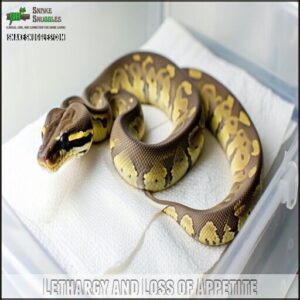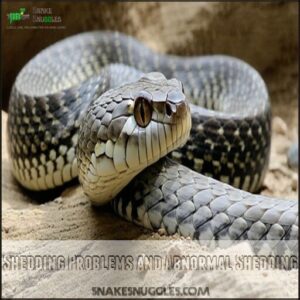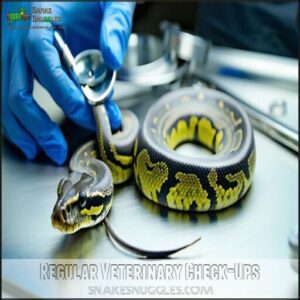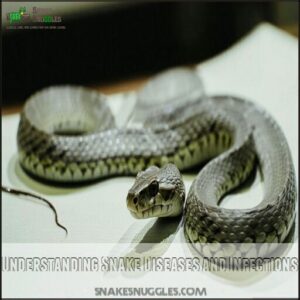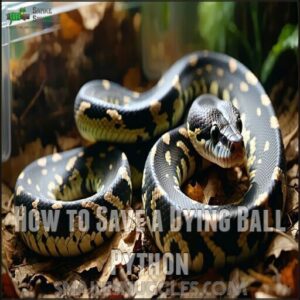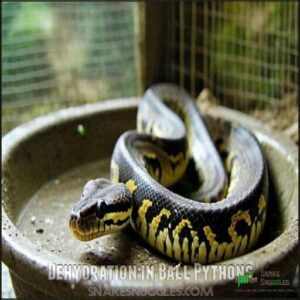This site is supported by our readers. We may earn a commission, at no cost to you, if you purchase through links.
 Your snake might have died suddenly due to several common causes: incorrect temperature or humidity levels, undiagnosed respiratory infections, impaction from substrate, or hidden genetic issues.
Your snake might have died suddenly due to several common causes: incorrect temperature or humidity levels, undiagnosed respiratory infections, impaction from substrate, or hidden genetic issues.
Like a car breaking down without warning signs, snakes can mask illness until it’s too late.
You’ll want to check if your setup maintained proper heating (75-95°F depending on species), humidity (50-70%), and whether there were subtle behavior changes you missed.
Even experienced owners sometimes miss the quiet distress signals these stoic creatures give, which is why understanding these environmental factors can help prevent similar heartbreak with future reptile companions.
As proper husbandry often makes all the difference, it’s crucial to ensure that your setup is well-maintained to avoid such incidents, and being aware of subtle behavior changes can be key to preventing them, ultimately leading to a better life for your reptile companions.
Table Of Contents
- Key Takeaways
- Common Reasons for Sudden Snake Death
- Signs of Illness in Snakes
- Preventing Future Snake Deaths
- Snake Died Suddenly: What to Do Next
- Understanding Snake Diseases and Infections
- How to Save a Dying Ball Python
- Is My Ball Python Dead or Hibernating?
- Dehydration in Ball Pythons
- When to Take Your Ball Python to The Vet
- Frequently Asked Questions (FAQs)
- Why did my pet snake suddenly die?
- What causes snakes to die suddenly?
- Is your pet snake dying?
- How long does it take a snake to die?
- Why do snakes die in a tank?
- What happens if a snake dies of old age?
- How Often Should I Check the Temperature of My Snake’s Cage?
- What Are the Signs of an Unhealthy Snake?
- Are There Any Precautions I Should Take When Handling My Snake?
- Is There a Safe Way to Store a Dead Snake?
- Conclusion
Key Takeaways
- Your snake likely died suddenly due to environmental factors like incorrect temperature (75-95°F) or humidity (50-70%), which can quickly compromise their immune system and lead to fatal complications.
- Watch for subtle warning signs of illness including lethargy, loss of appetite, abnormal movements, discharge from eyes or nose, and shedding problems—snakes often mask symptoms until conditions become severe.
- Maintain proper husbandry through regular cleaning, appropriate substrate choice, adequate ventilation, and multiple hiding spots to prevent common causes of death like respiratory infections, scale rot, and chronic stress.
- If your snake dies unexpectedly, handle the remains safely with gloves, consider a veterinary necropsy to identify the cause, check other reptile pets for similar symptoms, and review your setup to prevent future losses.
Common Reasons for Sudden Snake Death
Snakes can pass away suddenly due to a mix of environmental factors, health issues, or improper care that often goes unnoticed.
Understanding these common causes can help you spot potential problems early and keep your snake healthy.
Environmental Factors
Environmental factors are often the unsung villains in snake sudden death.
Your snake relies fully on you to maintain proper enclosure hygiene and temperature regulation. Tiny temperature fluctuations (just 5-10 degrees) can weaken their immune system.
Inadequate substrate choice may harbor bacteria, causing infections or impaction. Poor ventilation invites respiratory issues, and insufficient hiding spots lead to chronic stress.
- Tip: Regularly check humidity and temperature levels in all areas of the enclosure to avoid snake habitat issues.
Create the perfect balance for a healthy and thriving snake.
Health Issues and Diseases
Hidden health issues are often the root of snake sudden death, lurking until symptoms become severe. Respiratory infections are one of the most common snake health problems, signaled by wheezing, open-mouth breathing, or bubbles near the nostrils. Without treatment, they can spiral into fatal pneumonia.
Hidden health issues often lurk silently in snakes until they become fatal—early vigilance saves reptile lives.
Bacterial infections, like scale rot, occur when damp, dirty environments allow bacteria to attack the scales, causing painful discoloration and risking septicemia (blood poisoning). Mouth rot, often starting from a minor injury, can become life-threatening if left unchecked.
On top of that, parasitic infestations like mites sap energy, causing anemia and transmitting harmful diseases. Viral diseases such as Inclusion Body Disease (IBD) wreak havoc on the nervous system and are nearly always fatal.
Regularly watch for snake symptoms illness—like strange postures, soaking, or refusal to eat. Veterinary care helps catch these snake diseases early, improving survival.
Poor Husbandry and Handling
Neglecting the finer details of snake care can lead to sudden death—even if you think you’re doing everything right.
Poor husbandry often starts with inadequate enclosures or improper cleaning schedules. A dirty habitat creates the perfect storm for bacterial infections that can kill your snake quickly.
Failing at temperature control or maintaining ideal humidity is another common scenario. Snake temperature regulation isn’t optional—it’s essential. Without it, your pet could develop respiratory issues or stress-related conditions.
Even improper handling can harm your snake more than you might realize. Rough or excessive touching can stress them out, leading to meal refusal or weakened immunity.
To avoid these deadly mistakes, focus on these four basics:
- Maintain proper humidity and temperature levels for their species.
- Use safe, clean enclosures with quality substrate.
- Handle your snake minimally and gently to reduce stress.
- Stick to regular cleaning schedules to guarantee proper hygiene.
Genetic Defects and Inbreeding
Sometimes, sudden snake death stems from hidden genetic defects.
Inbreeding effects like immune deficiencies or lifespan reduction often strike morphs, especially those prized for unique appearances.
Spider Ball Pythons, for example, face notorious issues like neurological “wobble.”
Reputable breeders prioritizing genetic diversity reduce the risk of health complications.
Avoid breeders obsessed with aesthetics over wellbeing—your snake’s life depends on it.
Healthy genes offer insurance against these sneaky snake mortality causes, giving your pet a stronger shot at a healthy life, and are crucial for preventing issues like neurological “wobble”.
Signs of Illness in Snakes
When your snake acts differently, it’s often a sign that something’s wrong.
Changes like lethargy, odd movements, or unusual discharge shouldn’t be ignored, as they can point to serious health issues.
Lethargy and Loss of Appetite
Lethargy and appetite loss in snakes can signal serious underlying illnesses or environmental stressors. If your snake’s behavior feels "off," don’t brush it off—these are early warnings that something’s wrong.
A snake refusing food or staying hidden for long periods might be dealing with nutritional deficiencies, digestive issues, or parasites.
Watch for these signs:
- Unresponsiveness or lack of typical activity
- Consistent food refusal, even favorite prey
- Decreased shedding or sluggish movements
- Irregular waste elimination
Use quarantine protocols to isolate sick snakes and consult a vet ASAP when symptoms emerge. Ignoring them can lead to snake unexplained death or other snake mortality causes.
Shedding Problems and Abnormal Shedding
Shedding problems, or dysecdysis, are more than a bad scale day—they’re your snake’s way of waving a red flag.
When shedding difficulties show up, you’ll often spot warning signs like:
- Retained eyecaps, where old skin sticks to the eyes, risking long-term damage.
- Stuck shed patches, especially around the tail or head.
- Repeated abnormal shedding, possibly caused by poor humidity levels or hidden health issues.
Common dysecdysis causes include low humidity, improper enclosure setups, or overlooked supplement needs.
A dull or wrinkled appearance that doesn’t improve post-shed could also indicate snake stress or underlying health troubles.
Snake care mistakes, like ignoring low humidity levels or forgetting rough surfaces to help shedding, make matters worse.
A consistent shedding frequency signals good health.
If shedding frequency shifts dramatically, review your snake’s environment and humidity.
A properly hydrated snake always sheds like a champ!
Discharge From Eyes or Nose
If you notice discharge from your snake’s eyes or nose, it’s a warning sign of respiratory distress or possible infections.
Pay close attention to these snake symptoms, as untreated issues can quickly escalate.
- Clear mucus can indicate an early respiratory infection. Don’t ignore it.
- Yellow or green discharge points to bacterial or fungal infections, requiring a veterinary diagnosis.
- Bubbles around nostrils suggest a serious respiratory infection that needs immediate treatment.
Preventative care like maintaining proper humidity and clean enclosures reduces risks. If discharge persists or worsens, seek veterinary care promptly. Remember, your snake’s health relies on quick action and attention to symptoms.
Abnormal Movement and Posture
What’s your snake trying to tell you with its movements? Observing abnormal movement and posture can reveal serious snake symptoms that need quick attention.
Watch out for signs like:
- Star Gazing: Your snake tilts its head upward for long stretches—often tied to neurological issues.
- Muscle Tremors: Twitching or spasms can suggest incoordination or deeper health concerns.
- Spinal Curvature: A noticeable, unnatural bend in the spine is a warning signal.
- Inability to Right Itself: If your snake stays upside down or struggles to flip back, it’s alarming.
Sudden death could start with these subtle hints. Always consult a vet if your snake shows these behaviors, as conditions like respiratory infection may worsen quickly.
Dehydration and Weight Loss
Keeping an eye on hydration and weight is key to tracking your snake’s health.
Dehydration in snakes has clear symptoms: sunken eyes, wrinkled skin, and sticky mouth membranes. If left untreated, it leads to weakness, food refusal, and muscle wasting.
Causes often include low humidity, inadequate water access, or poor husbandry. Prevent dehydration by offering fresh water daily and maintaining appropriate humidity levels (usually 60-80% for most species).
Use a hygrometer to stay exact. Regularly weigh your snake—minor fluctuations aren’t alarming, but rapid weight loss paired with appetite issues signals trouble.
One key sign is difficulty with shedding, which is often linked to dehydration. For severe dehydration or ongoing weight loss, snake veterinary care is essential.
Early treatment guarantees recovery and prevents long-term effects on your snake’s health.
Preventing Future Snake Deaths
You can take simple steps to keep your snake healthy and prevent unexpected losses.
By creating the right environment, feeding properly, and staying alert to warning signs, you’ll give your pet the best chance to thrive.
Proper Humidity and Temperature Control
Without proper care, even healthy snakes can deteriorate fast, often due to overlooked environmental factors.
Temperature gradients and humidity levels aren’t just preferences—they’re essential.
Here’s how to keep things in check:
- Use thermostats to avoid overheating and guarantee thermostat calibration.
- Place thermometers on both ends to measure basking spots and cool zones (85–90°F warm, 75–80°F cool).
- Add hygrometers for consistent humidity monitoring across the enclosure.
Stay alert with twice-daily checks, and adjust seasonally to avoid sudden health issues like respiratory infections.
Many owners buy reliable reptile thermostats for superior control to ensure the well-being of their snakes, making it a crucial part of snake care to prevent deterioration due to environmental factors.
Safe and Non-Toxic Decorations
Keeping your snake comfortable starts with safe decorations. The wrong materials can off-gas harmful chemicals, putting your pet at risk. Always prioritize safe materials when designing a naturalistic snake environment.
Here’s a quick guide to decoration safety:
| Item | Safe Options | Avoid These |
|---|---|---|
| Substrate | Aspen, Coconut Fiber | Cedar, Pine |
| Hides | PVC, Natural Stone | Painted Ceramics |
| Enrichment | Cork Bark, Clay Pots | Metal, Treated Wood |
For easy cleanup, select washable, reptile-safe decor. You can easily find a suitable reptile substrate at many online retailers.
Secure all decorations to prevent tipping hazards. Plants—whether live or artificial—should be non-toxic and pesticide-free. Avoid overcrowding the enclosure; it stresses snakes and impedes movement.
Regular cleaning with a safe disinfectant keeps diseases at bay.
Regular Veterinary Check-Ups
Think of regular veterinary care as insurance for your snake’s health.
Scheduling check-ups every 6-12 months with an experienced snake vet helps catch hidden problems like parasites or respiratory infections early—before they spiral.
Even if your snake seems fine, a quick husbandry review or parasite screening might uncover issues you didn’t spot.
It’s especially helpful for aging snakes, whose health changes can be subtle.
Keep records to track their progress; it’s like a health diary for your pet.
And while no one wants bad news, early detection through preventative care guarantees better odds for snake treatment if problems arise down the road.
Proper Feeding and Hydration Techniques
Getting your snake’s feeding and hydration just right is like pairing socks—small mistakes can lead to big problems.
Proper prey size is key: stick with meals 1-1.5 times your snake’s middle width to avoid regurgitation or choking. Feed younger snakes once a week and adults every 2-3 weeks for ideal snake digestion. Understanding appropriate rodent size is essential for preventing feeding issues.
Don’t skimp on hydration—refresh water daily, scrub bowls clean, and use snake-safe water conditioners to dodge sneaky bacteria.
- Prey Size: Stick to 1-1.5 times mid-body width.
- Feeding Frequency: Weekly for young snakes, 2-3 weeks for adults.
- Hydration Methods: Daily water changes; supplement soaking during shedding.
Reducing Stress and Handling
Stress is often a hidden hazard for snakes, stemming from poor husbandry and disrupted living conditions.
To keep your snake healthy, handle it sparingly—brief, calm sessions (5-10 minutes) are ideal.
Support its body gently; avoid quick grabs or tight restraint, which amplify stress.
Ensure enclosure security and minimize nearby noise to create a peaceful environment.
New snakes need a gradual introduction, including quarantine, so they acclimate without added anxiety.
Watch for stress factors like defensive postures or hiding too much—these cues signal discomfort.
Prioritize proper snake care through consistent handling routines and safe, quiet surroundings, letting your pet grow relaxed and thrive in captivity.
Snake Died Suddenly: What to Do Next
Losing a snake unexpectedly can be a shock, but it’s important to focus on the next steps.
You’ll need to figure out what happened, handle the body safely, and check for any risks to other pets.
Identifying The Cause of Death
When your snake dies suddenly, figuring out the cause can feel overwhelming, but it’s a vital step for preventing future losses.
Start by observing post-mortem signs like discoloration, swelling, or injuries.
- Inspect the body: Look for symptoms of snake common diseases, such as scale or mouth rot.
- Review husbandry: Check for errors in temperature, humidity, or risky materials (e.g., toxins).
- Seek a vet necropsy: Professional tissue analysis can reveal hidden issues, from toxin exposure or organ failure to genetic factors.
Consulting a vet offers clarity on sudden death causes, ensuring better care for your other reptiles.
Safe Handling and Disposal
When your snake died quickly and handling the remains, safety comes first. Wear gloves to protect against zoonotic diseases, and refrigerate the body temporarily if needed. Always double-bag the carcass securely.
Explore these disposal methods:
| Disposal Method | Safety Tips | Legal Checkpoints |
|---|---|---|
| Burial | Dig 6+ inches; avoid water tables. | Confirm local regulations. |
| Cremation | Use professional services. | Check pet crematorium laws. |
| Veterinary | They sanitize thoroughly. | No legal issues involved. |
Wash your hands well after handling. It’s about staying cautious to prevent germ spread while showing respect. Safe handling and proper disposal not only protect you but guarantee ethical considerations are met. Snakes’ stoic nature often hides illnesses.
Checking for Signs of Illness in Other Pets
When your snake dies unexpectedly, it’s important to check your other reptiles for signs of illness.
Shared water bowls, decorations, or even close proximity can lead to cross-species transmission of infections or parasites. Watch for subtle signs of illness, like appetite changes, breathing difficulties, weight loss, or odd behavior.
Move any remaining pets to separate enclosures and follow strict quarantine protocols. This reduces shared environmental risks and gives you time to monitor their health without added stress.
Clean and disinfect any shared items to prevent lingering zoonotic diseases from spreading.
If you notice anything unusual, schedule a vet visit for preventative care. Catching early health problems could save your other pets—and give you peace of mind.
Seeking Veterinary Care and Advice
Losing a snake can be tough, but reaching out to a qualified reptile veterinarian can offer clarity and peace of mind.
A vet specializing in snake health will analyze your snake’s history, setup, and behavior. Bring photos of the habitat, feeding logs, and recent notes to help them piece everything together.
A necropsy, while not always cheap, provides valuable insights into potential causes of death and warns of risks to other reptiles. Follow-ups confirm recommended changes are effective.
- Pro tip: Check online exotic vet finders or telemedicine options if local resources are limited.
Preventative care, like regular check-ups and paying attention to subtle changes, can save lives. A good reptile vet can catch issues long before they become deadly.
Understanding Snake Diseases and Infections
Understanding snake diseases means knowing how infections like respiratory illnesses or mouth rot can silently harm your pet.
Spotting early signs, like wheezing or discolored scales, gives you a chance to act before it’s too late, which is crucial for the health of your pet.
Respiratory Infections (RI) and Treatments
Respiratory infections (RIs) can sneak up on your snake’s health.
Look for RI symptoms like wheezing, labored breathing, or mucus around the nostrils.
Often triggered by poor husbandry, RI causes include bacterial infections and low temperatures.
Poor husbandry isn’t just cutting corners—it’s often the silent killer behind your snake’s respiratory issues.
Treatment options often involve vet-prescribed antibiotics and correcting the enclosure’s temperature and humidity.
Act fast—snakes process medications slowly, so delays can lead to complications.
| Symptoms | Causes | Treatments | Prevention |
|---|---|---|---|
| Wheezing | Bacteria | Antibiotics | Proper ventilation |
| Raised head | Viruses | Increased humidity | Clean enclosure |
| Mucus discharge | Low temperatures | Humidifier usage | Regular vet check-ups |
| Stuck tongue tines | Humidity imbalance | Fluid replacement | Monitor temperature |
Stay proactive—healthy husbandry is your best defense!
Scale Rot and Mouth Rot Causes and Symptoms
If your snake has reddish-brown or blackened belly scales, it could be scale rot, and if there’s whitish-yellow pus around its gums, it’s likely mouth rot.
Both result from bacterial infections fueled by poor snake hygiene, damp substrate, or untreated wounds. Left unchecked, these conditions worsen fast, affecting your snake’s health and ability to eat.
Here’s what to look for:
- Discolored or soft belly scales that may seem wet or greasy
- Fluid-filled blisters or ulcers, often in infected areas
- Swollen gums or mouth, sometimes with pus discharge
- Decreased activity caused by pain or infection severity
To prevent these issues, maintain clean enclosures, correct humidity, and treat snake wounds promptly. If symptoms appear, seek ulcer treatment and pain management immediately via a vet. Staying on top of routine cleaning and monitoring guarantees these bacterial culprits don’t get the upper hand.
Stress and Its Effects on Snakes
Without saying a word, your snake can tell you it’s stressed. Refusing food, hiding too much, or acting defensive are all clear behavioral indicators of stress.
Common snake stress factors include sudden temperature changes, lack of proper hiding spots, or overhandling. Housing multiple snakes? That can crank up housing stressors, as most species prefer solitude.
Poor handling techniques can also disrupt their peace. To keep your snake happy and healthy, prioritize environmental enrichment: provide consistent temperatures, multiple hiding spots, and a peaceful space.
Remember, a settled snake handles life (and you!) much better when given a supportive, low-stress environment.
Common Parasites and How to Treat Them
Dealing with snake parasites can feel overwhelming, but knowing the signs and treatments makes a big difference. Internal parasites like roundworms, tapeworms, and protozoan infections cause weight loss, lethargy, and digestive problems. Deworming snakes with vet-prescribed medication often resolves these issues.
Ticks and mites, common external parasites, irritate your snake’s skin and drain energy. For mite infestations, use topical treatment paired with thorough cleaning.
- Watch for symptoms like regurgitation, visible parasites, or diarrhea.
- Quarantine new snakes to avoid spreading parasites.
- Clean the enclosure regularly to prevent reinfestation.
When facing a parasite infestation, consult an exotic vet for diagnosis and treatment. Consistent care and habitat sanitization keep parasites under control, ensuring your snake stays healthy.
How to Save a Dying Ball Python
If your ball python seems unwell, quick action can make all the difference.
Learn how to recognize warning signs and provide emergency care to give your snake the best chance of recovery.
Recognizing The Signs of a Dying Snake
Spotting a dying snake means catching the subtle symptoms it’s trying to hide.
Snakes often mask disease symptoms until it’s too late, so knowing key behavioral changes and physical indicators is your best defense against sudden snake death.
Watch for emergency signs like breathing difficulties (wheezing, mouth breathing), anorexia (refusal to eat), abnormal posture (head tilting, tight coiling), or discharge (wet, foamy mouth).
Swift response testing is essential—unusual lethargy, spine visibility, or sluggish responses signal trouble.
Snakes rarely broadcast their discomfort, so check them daily.
Think of your consistent care as early intervention—it could save your snake’s life.
Stay proactive!
Emergency Care and First Aid
A snake emergency can feel overwhelming, but acting fast and smart is vital.
Whether it’s wound care, burn treatment, or toxin exposure, a quick response can save your snake‘s life.
Here’s a handy checklist:
- Wound Care: Clean cuts with diluted betadine and gently disinfect the area.
- Burn Treatment: Cool minor burns with clean water—don’t use creams unless advised by a vet.
- Prolapse Management: Keep the area moist with saline, and get to a snake vet urgently.
- Toxin Exposure: Rinse your snake if exposed to irritants—never delay a vet visit.
- Seizure Response: Minimize handling and reduce stress immediately.
Keep your snake warm, hydrated, and calm while you arrange professional help.
It’s all about buying precious time.
Seeking Veterinary Care and Treatment
Getting help from a trusted reptile vet is your top priority after giving first aid. Not all vets know snake physiology, so find an Exotic Vet Finder now rather than in an emergency later.
Bring details about your snake’s symptoms, habitat, and diet—this can speed up a snake vet diagnosis.
Tests like blood work or imaging may uncover snake poisoning signs, respiratory infections, or internal parasites.
Here’s how diagnostic tools stack up:
| Test Type | Purpose | Example Issue Found |
|---|---|---|
| Blood Test | Check organ function | Snake toxic exposure |
| Fecal Exam | Detect internal parasites | Snake internal parasites |
| Imaging (X-ray) | Spot physical issues | Respiratory infection |
Quick action saves lives, and remember, treatment costs protect your snake’s future.
Preventing Future Health Issues
Preventing future health issues in your snake is all about creating a solid care routine. Think of it as laying the groundwork for a long, healthy life. A few small adjustments can make a big difference.
Here’s your prevention to-do list:
- Quarantine Protocols: Isolate new arrivals for at least 30 days to avoid spreading illness.
- Proactive Monitoring: Check temperature, humidity, and ventilation daily—consistency is key.
- Husbandry Improvements: Clean enclosures weekly, disinfect surfaces, and avoid harmful substrates.
- Enrichment Strategies: Add climbing structures and hiding spots to reduce stress and boredom.
Learning your snake’s specific needs and considering genetic screening when buying guarantees better care. Remember, prevention is easier than recovery—your snake will thank you (in its own way).
Is My Ball Python Dead or Hibernating?
If your ball python isn’t moving, it’s natural to wonder if it’s dead or simply in a state of brumation.
Knowing how to check for life signs can help you figure out what’s really going on.
Signs of Hibernation and Brumation
Brumation often looks like a snake’s version of a deep nap.
But how do you know it’s not something more serious? During this phase, your ball python might show these behaviors:
- Reduced Activity: Slowed movement and longer rest periods.
- Appetite Changes: Refusing meals for weeks is normal.
- Temperature Preference: They’ll seek cooler spots.
- Water Intake: Drinking less often but still occasionally.
These signs reflect natural cycles, not alarm.
How to Check for Vital Signs
To check if your python’s alive, start with pupil response by shining a light—movement signals life.
Feel for a faint heart rate near the lower third of its body.
Look closely for breathing signs, like minimal chest movement or subtle muscle tone.
If there’s no movement or reflex response when handled gently, mortality may be likely.
Always confirm life signs carefully to avoid assumptions about snake death.
What to Do if You’re Unsure
If you’re unsure whether your snake has passed away or is hibernating, it’s okay to feel uncertain. A veterinary consultation is the best way to get answers. Reptile vets can perform a post-mortem exam or necropsy to pinpoint the cause of death and rule out neglect or illness.
In the meantime, take steps to preserve the body for evaluation:
- **Document enclosure temperature, humidity, and recent behaviors.
- **Place the body in a sealed, cool, dry container.
- **Photograph any unusual signs, like discolored scales or injuries.
- **Avoid moving or handling the body excessively.
Recognizing signs of illness can be vital even after death, providing clues to underlying conditions. Understanding the causes of death—including habitat issues or undetected illnesses—helps avoid future challenges. A snake autopsy cost is often worth the peace of mind for you and protection for other pets.
Dehydration in Ball Pythons
Dehydration is a common but often overlooked issue in ball pythons that can quickly turn serious if not addressed.
If your snake’s skin seems wrinkled or it’s soaking more than usual, it might be trying to tell you it needs better hydration.
Causes and Symptoms of Dehydration
Dehydration is a sneaky threat to your snake’s health, especially when humidity levels aren’t consistent.
Your ball python depends on proper hydration to maintain essential functions, and even minor water loss can impact reptile health substantially.
Watch for common snake dehydration signs like:
- Dry, wrinkled skin—a loss of skin elasticity shows trouble brewing.
- Sunken, dull eyes—a telltale indicator your snake’s moisture is dangerously low.
- Thick mucus or waste—signals their body is struggling to conserve fluids.
Temperature fluctuations or a lack of water sources can quickly worsen dehydration.
Without proper humidity levels, symptoms escalate into lethargy signs and serious issues within days.
Keep your ball python’s enclosure moist and monitor behaviors to prevent this silent danger from overwhelming their delicate system.
How to Recognize Dehydration
How can you spot dehydration in your snake before it becomes life-threatening?
Look for these five key warning signs:
Sign
What to Look For
—
Skin elasticity
Sunken eyes
Thick saliva
Weight loss
Reduced urination
Snake humidity levels directly impact hydration – poor husbandry often leads to these dehydration signs.
Treatment and Prevention Methods
Now that you know what dehydration looks like, let’s tackle how to fix it and prevent it from happening again.
Rehydrating your ball python requires prompt action with these proven methods:
- Create humidity refuges with damp sphagnum moss in hide boxes where your snake can naturally rehydrate
- Provide a clean water bowl large enough for soaking but not so deep your snake risks drowning
- Maintain 50-60% humidity by misting the enclosure daily and using digital hygrometers for accuracy
- Implement regular quarantine protocols for new snakes to prevent introducing pathogens
For severe cases, veterinary care might include specialized electrolyte solutions.
Monthly enclosure sanitation prevents respiratory infections and other health complications.
Proper husbandry adjustments—including supplementation strategies and probiotic use—can strengthen your snake’s immune system, making prevention much easier than treatment.
When to Take Your Ball Python to The Vet
You’ll need to get your ball python to the vet immediately if you notice breathing problems, unusual discharge, mouth rot, or difficulty shedding, as these symptoms can quickly become life-threatening.
Regular check-ups every 6-12 months can help catch hidden health issues before they develop into serious problems that could lead to sudden death.
Regular Check-Ups and Preventative Care
Establishing preventative healthcare for your pet snake starts with finding a qualified reptile veterinarian. Unlike mammals, snakes often hide illness until it’s severe, making regular vet checkups essential for extending your snake’s lifespan.
Schedule veterinary visits every 6-12 months for thorough health assessments that include:
- Weight monitoring and nutritional needs evaluation to prevent obesity or malnutrition
- Parasite screening through fecal exams to catch infestations before they cause damage
- Habitat maintenance recommendations customized to your specific snake species
Between appointments, maintain detailed records of feeding, shedding, and behavior patterns. These observations help with early detection of potential issues. A vital aspect involves understanding ideal humidity levels to prevent stuck sheds.
New snake owners should implement quarantine protocols for any additions to their collection—keeping newcomers separate for 30-60 days prevents disease spread. Remember, safe handling techniques during home examinations complement professional care, not replace it.
Signs of Illness and Injury
Many snakes mask illness until it’s severe. Watch for behavioral changes like refusing meals, unusual posture, or decreased activity.
Skin abnormalities such as incomplete shedding, discolored scales, or blisters indicate problems. Breathing problems manifest as wheezing or open-mouth breathing.
Unusual discharges around the mouth, nose, or cloaca suggest infection. Swelling/lumps anywhere on your snake’s body warrant immediate veterinary attention.
Don’t ignore subtle symptoms—early detection substantially improves treatment outcomes. Remember, your snake can’t tell you when it’s sick.
Emergency Situations and What to Do
While regular checkups flag potential issues, true emergencies require immediate action to save your snake’s life.
When seconds count, you’ll need to act fast to protect your beloved reptile.
Here’s what to do when facing snake emergencies:
- Assess essential signs – Look for subtle breathing movements and test response to gentle touch along the spine for trauma response.
- Control bleeding – Apply gentle pressure with clean gauze for any bleeding control emergencies.
- Manage prolapses – Keep tissue moist with sugar water while seeking immediate prolapse management.
- Address respiratory distress – Elevate enclosure humidity for snakes struggling to breathe.
Don’t waste precious minutes with toxin exposure or choking hazards – head straight to an exotic vet.
Remember, snake mortality often hinges on these critical first moments, so keep your emergency vet’s number saved in your phone.
Frequently Asked Questions (FAQs)
Why did my pet snake suddenly die?
Your snake’s sudden death may have resulted from environmental issues like incorrect temperature, respiratory infections, parasites, or stress. Hidden health problems can develop quickly in reptiles before showing obvious symptoms.
What causes snakes to die suddenly?
Like a bolt from the blue, snakes can die suddenly from improper temperature, respiratory infections, scale rot, toxins, injuries, or stress.
You’ll often find that husbandry issues or hidden illnesses are the culprits.
Is your pet snake dying?
If you’re noticing concerning symptoms like reduced activity, breathing problems, or unusual postures, your snake may be ill.
Don’t wait – consult a reptile vet immediately for proper diagnosis and treatment.
How long does it take a snake to die?
The timeframe varies greatly depending on causes – from minutes with severe injuries or poisoning to weeks with illness.
Your snake’s death speed depends on the specific health issue and environmental conditions.
Why do snakes die in a tank?
Your snake may die in a tank due to improper temperature, poor humidity, unclean conditions, inadequate ventilation, toxic substances, stress, or improper feeding.
Regular habitat maintenance and monitoring prevent most captivity deaths, and this is crucial for the snake’s survival, highlighting the importance of proper care.
What happens if a snake dies of old age?
Every journey has its sunset.
When your snake reaches old age, you’ll notice gradual slowing, reduced appetite, and less activity.
Their body naturally shuts down peacefully, with organs gradually failing until they pass quietly.
Their sunset is a natural part of their life cycle, and it is a peaceful process.
How Often Should I Check the Temperature of My Snake’s Cage?
You should check your snake’s cage temperature twice daily – morning and evening.
Weekly verification with a secondary thermometer helps catch faulty equipment.
Immediate checks are needed after power outages or thermostat adjustments, and it is crucial for maintaining the right environment, thus weekly verification is a must.
What Are the Signs of an Unhealthy Snake?
Like silent warning flags, your snake’s unhealthy signs include dull or discolored scales.
Weight loss, difficulty breathing, discharge around mouth or nose, and irregular shedding are also signs.
Lethargy, loss of appetite, and abnormal posture or movement are further indicators.
Are There Any Precautions I Should Take When Handling My Snake?
Wash your hands before handling, support your snake’s body fully, and avoid squeezing. Don’t handle during shedding or after feeding. Keep sessions short, especially with new snakes, to minimize stress.
Is There a Safe Way to Store a Dead Snake?
Nearly 65% of reptile owners struggle with proper preservation methods.
Store your dead snake in a sealed plastic bag in the freezer until you can arrange for cremation, burial, or preservation by a taxidermist.
Conclusion
Discovering why your snake died suddenly can be heartbreaking yet enlightening.
By monitoring temperature, humidity, behavior changes, and seeking prompt veterinary care, you’ll become more attuned to subtle warning signs.
Remember, even experienced owners miss critical symptoms sometimes.
Your next reptile companion will benefit from the knowledge you’ve gained through this difficult experience.
When you understand the environmental factors and health indicators that affect your snake’s wellbeing, you’re better equipped to provide the care these fascinating creatures deserve, and this understanding can be enlightening.


